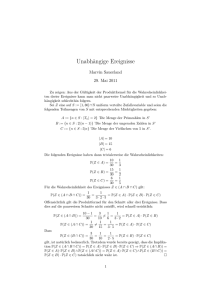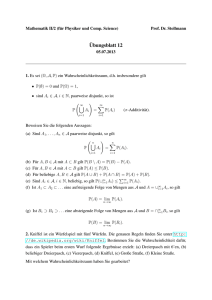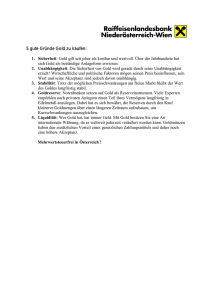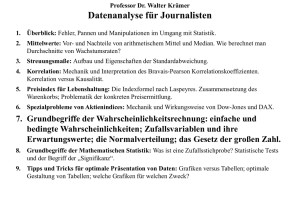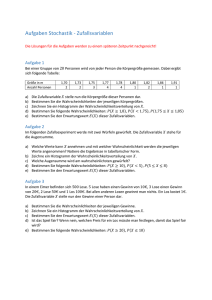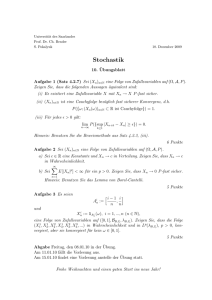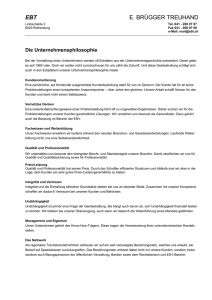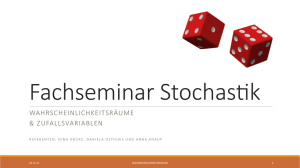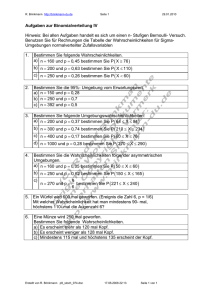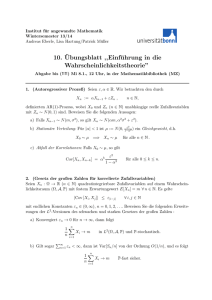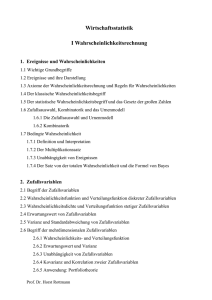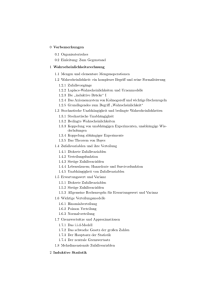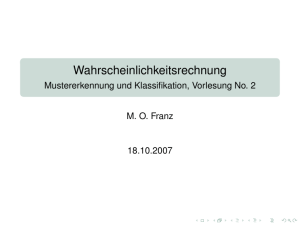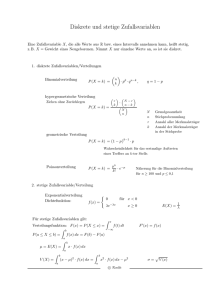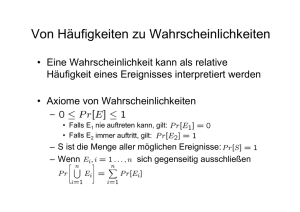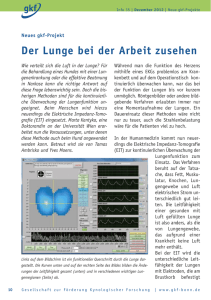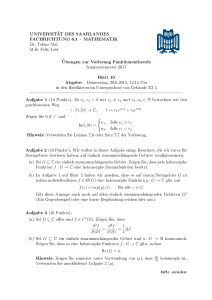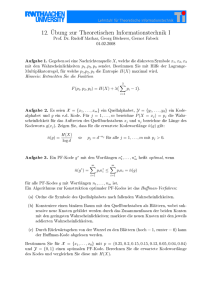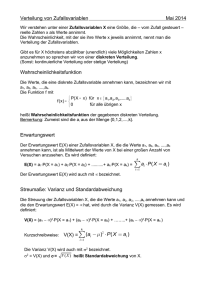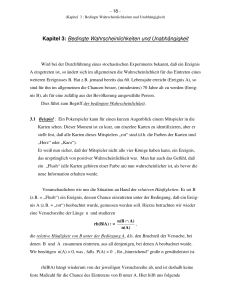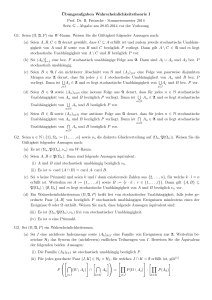Musterlösung Wahrscheinlichkeitstheorie und Statistik - D-MATH
Werbung
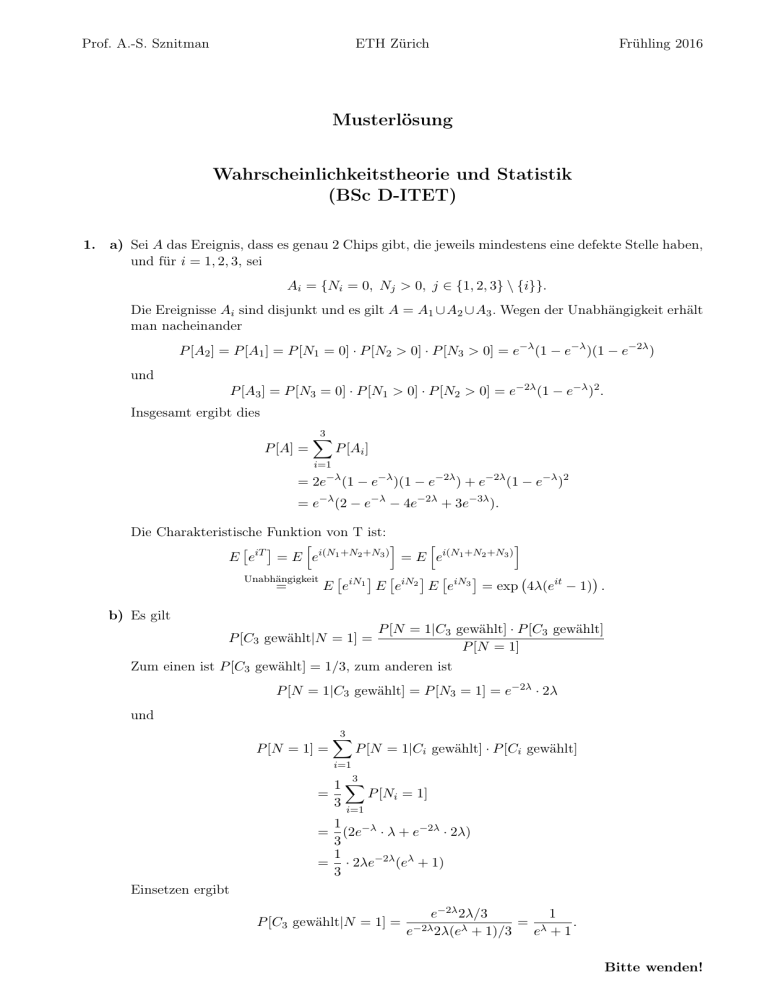
Prof. A.-S. Sznitman
ETH Zürich
Frühling 2016
Musterlösung
Wahrscheinlichkeitstheorie und Statistik
(BSc D-ITET)
1. a) Sei A das Ereignis, dass es genau 2 Chips gibt, die jeweils mindestens eine defekte Stelle haben,
und für i = 1, 2, 3, sei
Ai = {Ni = 0, Nj > 0, j ∈ {1, 2, 3} \ {i}}.
Die Ereignisse Ai sind disjunkt und es gilt A = A1 ∪ A2 ∪ A3 . Wegen der Unabhängigkeit erhält
man nacheinander
P [A2 ] = P [A1 ] = P [N1 = 0] · P [N2 > 0] · P [N3 > 0] = e−λ (1 − e−λ )(1 − e−2λ )
und
P [A3 ] = P [N3 = 0] · P [N1 > 0] · P [N2 > 0] = e−2λ (1 − e−λ )2 .
Insgesamt ergibt dies
P [A] =
3
X
P [Ai ]
i=1
= 2e−λ (1 − e−λ )(1 − e−2λ ) + e−2λ (1 − e−λ )2
= e−λ (2 − e−λ − 4e−2λ + 3e−3λ ).
Die Charakteristische Funktion von T ist:
i
i
h
h
E eiT = E ei(N1 +N2 +N3 ) = E ei(N1 +N2 +N3 )
Unabhängigkeit
=
E eiN1 E eiN2 E eiN3 = exp 4λ(eit − 1) .
b) Es gilt
P [C3 gewählt|N = 1] =
P [N = 1|C3 gewählt] · P [C3 gewählt]
P [N = 1]
Zum einen ist P [C3 gewählt] = 1/3, zum anderen ist
P [N = 1|C3 gewählt] = P [N3 = 1] = e−2λ · 2λ
und
P [N = 1] =
3
X
P [N = 1|Ci gewählt] · P [Ci gewählt]
i=1
3
=
1X
P [Ni = 1]
3
i=1
1
= (2e−λ · λ + e−2λ · 2λ)
3
1
= · 2λe−2λ (eλ + 1)
3
Einsetzen ergibt
P [C3 gewählt|N = 1] =
e−2λ 2λ/3
1
= λ
.
−2λ
λ
e 2λ(e + 1)/3
e +1
Bitte wenden!
2. Lösung:
a) • Die Verteilung von (U, V ) ist gegeben durch
P [U = 0, V = 0] = a,
P [U = 0, V = 1] = P [U = 0] − P [U = 0, V = 0] = 1/4 − a,
P [U = 1, V = 0] = P [V = 0] − P [U = 0, V = 0] = 1/2 − a,
P [U = 1, V = 1] = 1 − P [U = 0, V = 0] − P [U = 1, V = 0] − P [U = 0, V = 1]
= 1 − a − (1/2 − a) − (1/4 − a) = 1/4 + a.
Da P [U = 0, V = 0], P [U = 0, V = 1] u.s.w. Wahrscheinlichkeiten sein müssen, also Zahlen
zwischen 0 und 1, darf a nur Werte in [0, 1/4] annehmen.
• Die Zufallsvariablen U und V sind genau dann unabhängig, wenn für i, j = 0, 1 gilt:
P [U = i, V = j] = P [U = i]P [V = j].
Dies gilt hier für a = 1/8.
b) Es gilt:
E[U ] = 0 · P [U = 0] + 1 · P [U = 1] = 1 − 1/4 = 3/4,
E[V ] = 0 · P [V = 0] + 1 · P [V = 1] = 1 − 1/2 = 1/2,
E[U V 2 ] = 0 · P [U V 2 = 0] + 1 · P [U V 2 = 1] = P [U = 1, V = 1] = 1/4 + a.
